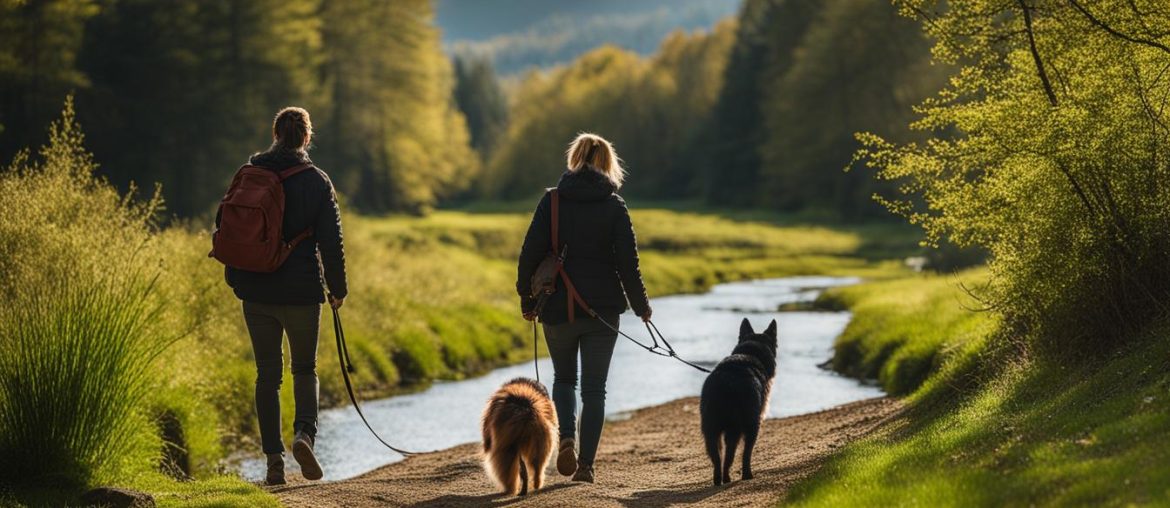Loose leash walking is a crucial skill for dog owners to master, as it allows for enjoyable and stress-free walks with their furry companions. In this comprehensive guide, I will provide you with the basic tools and techniques needed to achieve loose leash walking success. We will cover topics such as choosing the right equipment, establishing a foundation of basic obedience, and using positive reinforcement techniques. Get ready to enhance your dog walking experience and foster a better bond with your dog through loose leash walking.
Key Takeaways:
- Loose leash walking improves the overall walking experience for both you and your dog.
- Choosing the right equipment, such as a collar or harness, treat pouch, and clicker, is essential for successful loose leash walking.
- Establishing a foundation of basic obedience, including commands like “sit” and “stay,” sets the stage for successful loose leash walking.
- Starting indoors and gradually introducing distractions helps build your dog’s skills and focus for loose leash walking.
- Consistency, patience, and positive reinforcement are key to achieving loose leash walking success.
The Importance of Loose Leash Walking
Loose leash walking is a fundamental skill that every dog owner should strive to master. It not only enhances the walking experience for both you and your furry companion but also lays the foundation for a well-behaved and obedient pet. By teaching your dog to walk by your side without pulling on the leash, you create a harmonious and enjoyable walking routine.
There are several reasons why loose leash walking is crucial. First and foremost, it promotes safety. When a dog pulls on the leash, it can lead to accidents, such as tripping or being dragged. By teaching your dog to walk on a loose leash, you can prevent these potentially dangerous situations.
Furthermore, loose leash walking allows for better control and communication between you and your dog. It encourages your pet to focus on you and stay attentive to your cues. This improves obedience and helps establish you as the leader of the pack.
Lastly, loose leash walking provides mental stimulation for your dog. By maintaining a calm and focused walk, your dog is engaged in the environment and less likely to become distracted or reactive to various stimuli. This helps reduce behavioral issues and promotes a more relaxed and peaceful walking experience.
So, if you’re looking to enhance your walks with your furry friend, I would advise that you invest time and effort into teaching loose leash walking. In the next sections, we’ll explore various techniques, tips, and exercises to help you achieve loose leash walking success.
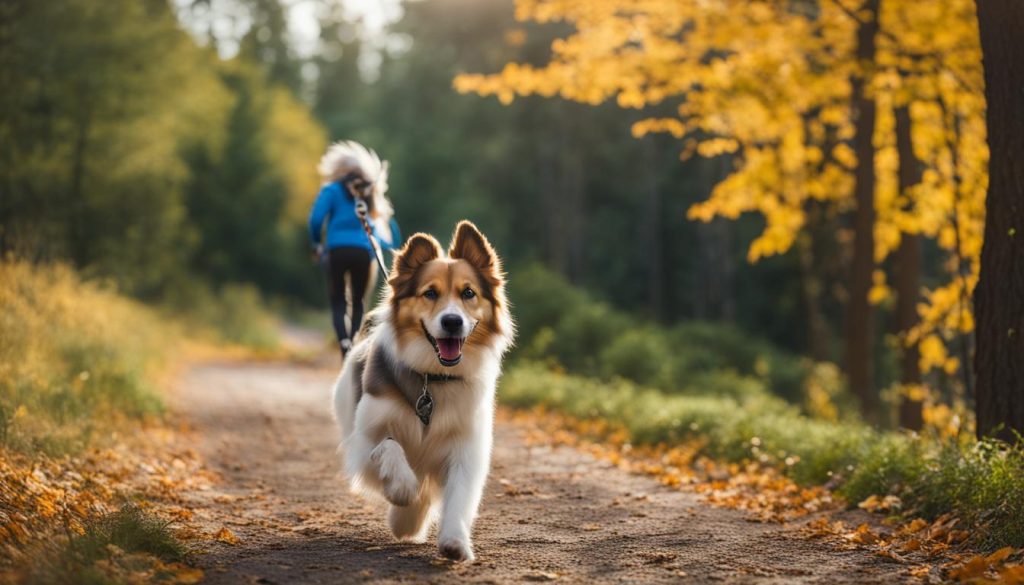
Why Loose Leash Walking Matters
The importance of loose leash walking cannot be overstated. It is not only a matter of convenience and safety, but it also plays a significant role in the overall behavior and well-being of your dog. By mastering loose leash walking techniques, you empower yourself to take control of your walks and create a positive experience for both you and your pet.
When your dog walks calmly by your side on a loose leash, it demonstrates that they are focused, responsive, and well-behaved. This level of obedience strengthens the bond between you and your pet and establishes a foundation for good behavior in other areas of their life.
Moreover, loose leash walking allows your dog to explore the world around them while still maintaining boundaries and respecting your guidance. This balance ensures that your pet enjoys mental stimulation and exercise without becoming overwhelmed or engaging in undesirable behaviors, such as jumping, lunging, or excessive pulling.
By prioritizing loose leash walking, you set yourself and your dog up for success in various situations. Whether you’re strolling through a crowded park, walking in a neighborhood with distractions, or encountering other dogs on your route, your dog’s ability to walk politely on a loose leash will make every outing more enjoyable and stress-free.
Essential Tools for Loose Leash Walking
When it comes to training your dog for loose leash walking, having the right tools can make all the difference. These tools not only aid in effective communication but also ensure the safety and comfort of both you and your furry companion. Here are some essential tools that you should consider:
- Treat Pouch: A treat pouch is a convenient accessory that allows you to keep rewards handy during your walks. It helps you quickly reinforce positive behavior and keep your dog engaged in the training process.
- Treats: Treats are a valuable tool for motivating your dog and rewarding them for walking calmly on a loose leash. Choose small, soft treats that your dog finds enticing to make the training experience enjoyable.
- Collar or Harness: A well-fitted collar or harness provides control and ensures that your dog is comfortable during walks. Choose a collar or harness that doesn’t encourage pulling and allows for proper leash attachment.
- Clicker: A clicker is a useful tool for marking desired behaviors during loose leash walking training. The sound of the clicker serves as a signal to your dog that they have done something right, making it easier to reinforce positive behavior.
- Biothane Leash: A biothane leash is a durable and lightweight option that offers comfort and reliability. It is resistant to water, odor, and dirt, making it ideal for outdoor walks.
With the right tools in hand, you’ll be well-equipped to tackle loose leash walking training with confidence. Try to choose tools that suit your dog’s individual needs and preferences. The goal is to create a positive and enjoyable walking experience for both of you.

Table: Recommended Brands for Loose Leash Walking Tools
| Tool | Recommended Brand |
|---|---|
| Treat Pouch | Ruffwear Treat Trader |
| Treats | Zuke’s Mini Naturals |
| Collar | Martingale Collar |
| Harness | Freedom No-Pull Harness |
| Clicker | Karen Pryor i-Click |
| Leash | Biothane Leash by Biothane Direct |
Training Techniques for Loose Leash Walking
When it comes to teaching your dog loose leash walking, there are several effective techniques you can implement. One popular method is the “Be a Tree” technique. This technique involves stopping and standing still whenever your dog pulls on the leash. By doing this, you are teaching your dog that pulling does not result in forward progress. This technique requires consistency and patience, but over time, your dog will learn to walk calmly by your side.
Another technique you can try is the “Turn and Walk” method. With this technique, you calmly change direction whenever your dog pulls on the leash. By doing so, you redirect your dog’s attention back to you and discourage pulling behavior. The key to success with the “Turn and Walk” method is to remain calm and be consistent in your redirections.
In addition to these techniques, positive reinforcement is a powerful tool in loose leash walking training. When your dog walks politely on a loose leash, be sure to praise them, offer treats, or engage in play as a reward. This positive reinforcement helps your dog associate loose leash walking with positive outcomes, making them more likely to repeat the desired behavior.
To put it simply, consistency is key when it comes to loose leash walking training. Practice these techniques regularly and be patient with your dog. With time and effort, you will see progress and enjoy stress-free walks with your furry companion.

Establishing a Foundation of Basic Obedience
Before diving into loose leash walking training, you should establish a foundation of basic obedience with your dog. This foundation will provide the building blocks for successful loose leash walking and ensure a smoother training process. By teaching your dog basic commands such as “sit,” “stay,” and “come,” you are fostering focus, responsiveness, and a stronger bond between you and your furry friend.
Basic obedience commands serve as valuable tools during loose leash walking. For example, teaching your dog to “sit” before crossing the street can help reinforce impulse control and prevent potential dangers. Similarly, a reliable “stay” command can be utilized when encountering distractions such as other dogs or cyclists during walks.
When beginning your loose leash walking training, dedicate time to practicing and reinforcing basic obedience commands in a controlled environment. By ensuring your dog understands and responds to these commands, you will set a solid foundation for success when venturing out into more distracting and challenging environments.
Building Blocks for Success:
- Teach basic commands such as “sit,” “stay,” and “come.”
- Use positive reinforcement techniques to motivate and reward desired behavior.
- Create a consistent training routine with dedicated practice sessions.
- Gradually increase distractions and challenges as your dog progresses.
To put it simply, loose leash walking is a skill that takes time and patience to develop. By establishing a foundation of basic obedience, you are setting both you and your dog up for success in your loose leash walking journey.

Starting Indoors for Training
When it comes to training your dog to walk on a loose leash, starting indoors in a low-distraction environment can be incredibly beneficial. By beginning the training process indoors, you can create a controlled space where your dog can focus on learning without the added distractions of the outdoors. This allows you to establish the foundation of loose leash walking and set your dog up for success.
To start, observe when your dog becomes excited or eager to go for a walk, such as when they see you grabbing the leash or heading towards the door. Use these moments as opportunities to practice walking on a leash indoors. Walk in different areas of your home, such as from one room to another or down a hallway, mimicking the motions and behaviors that would typically occur during an outdoor walk.
By practicing loose leash walking indoors, you can teach your dog that opening the door doesn’t always lead to an immediate walk. This helps prevent whining, tantrums, or excessive pulling towards the door. It also allows you to focus solely on the training process, reinforcing positive behaviors and gently redirecting any pulling or lunging tendencies.
To put it simply, consistency and patience are key during this indoor training phase. By starting indoors, you can establish a solid foundation of loose leash walking before progressing to more challenging outdoor environments.
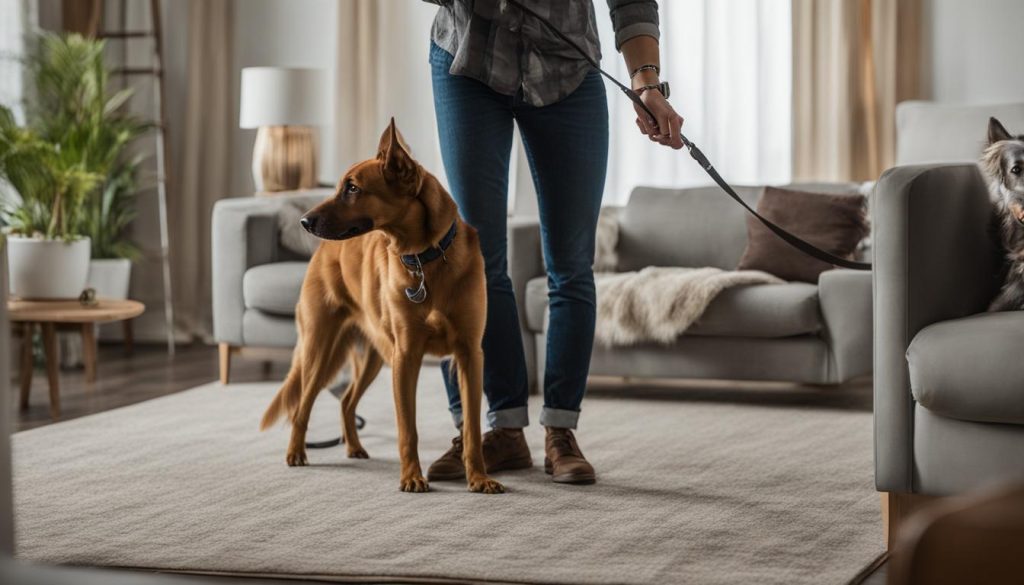
Structured Walks for Success
Structured walks are an essential component of loose leash walking training. These walks go beyond just exercise, as they require focus and attention from both you and your dog. During a structured walk, the goal is for your dog to walk calmly and politely by your side without engaging in sniffing, marking, or greeting other dogs or distractions.
Implementing structured walks helps establish leadership and boundaries, making the walking experience enjoyable and mentally stimulating for your dog. It teaches them to pay attention to your cues and reinforces the concept of walking as a cooperative activity. Structured walks also provide an opportunity for you to practice your own leadership skills and reinforce your role as their guide.
To have successful structured walks, set clear expectations and be consistent in your training. Start by practicing in low-distraction environments before gradually increasing the difficulty level. Set a steady pace and encourage your dog to focus on you by using verbal cues, such as “heel” or “walk with me.” Keep the leash loose and maintain a calm and assertive demeanor throughout the walk.
Try to reward your dog for good behavior during structured walks. Have treats or praise ready to reinforce their polite walking and encourage them to continue exhibiting the desired behavior. With consistent practice and positive reinforcement, your dog will become more proficient in loose leash walking and enjoy the benefits of structured walks.
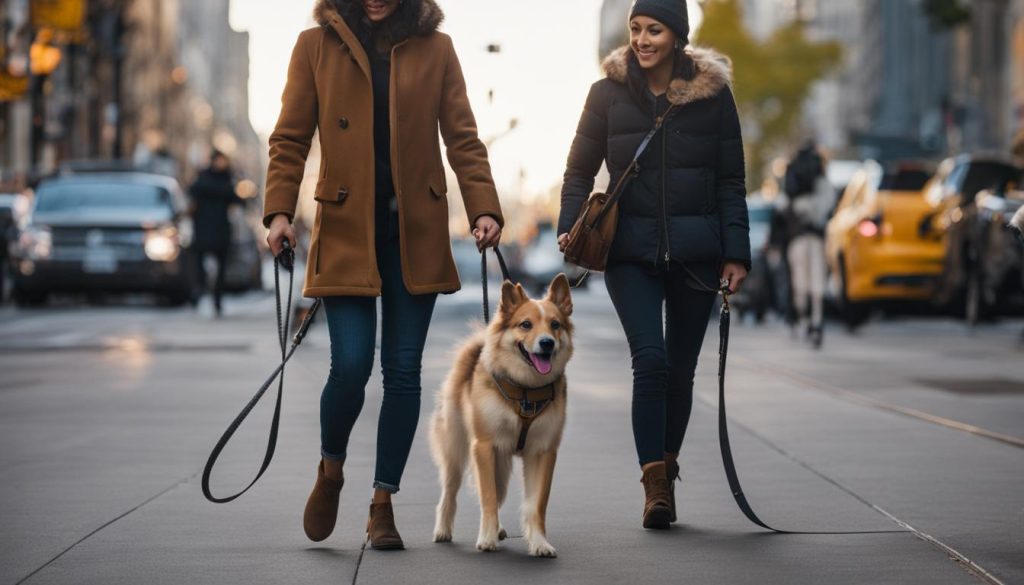
The Benefits of Structured Walks
- Establishes leadership and boundaries
- Improves focus and attention
- Creates a cooperative walking experience
- Provides mental stimulation
- Reinforces role as a guide
The Power of Positive Reinforcement
Positive reinforcement is a highly effective technique when it comes to loose leash walking. By using rewards such as praise, treats, or playtime, you can motivate your dog to walk politely on a loose leash. This positive association helps them understand that walking calmly by your side leads to enjoyable outcomes. I recommend that you use positive reinforcement consistently throughout your training sessions to reinforce the desired behavior.
When practicing loose leash walking, remember to reward your dog immediately when they exhibit the desired behavior. This will help them understand what they are being rewarded for and reinforce the connection between walking on a loose leash and positive experiences. It’s also essential to use high-value treats that your dog finds particularly enticing, as this will increase their motivation to maintain loose leash walking.
Positive reinforcement not only teaches your dog to walk politely on a loose leash, but it also strengthens the bond between you and your furry companion. When you reward your dog for good behavior, it builds trust and encourages a positive relationship based on mutual understanding. This positive interaction during training sessions can contribute to a happier and more cooperative attitude in your dog, making future training endeavors more successful.
To put it simply, positive reinforcement is all about focusing on what your dog is doing right and rewarding that behavior. By consistently rewarding your dog for walking on a loose leash, you will create a positive training experience and encourage them to continue exhibiting the desired behavior.
By implementing positive reinforcement techniques in your loose leash walking training, you can transform your walks into enjoyable experiences for both you and your dog. The power of positive reinforcement lies in its ability to motivate and encourage desired behavior, ultimately leading to long-term success in loose leash walking.
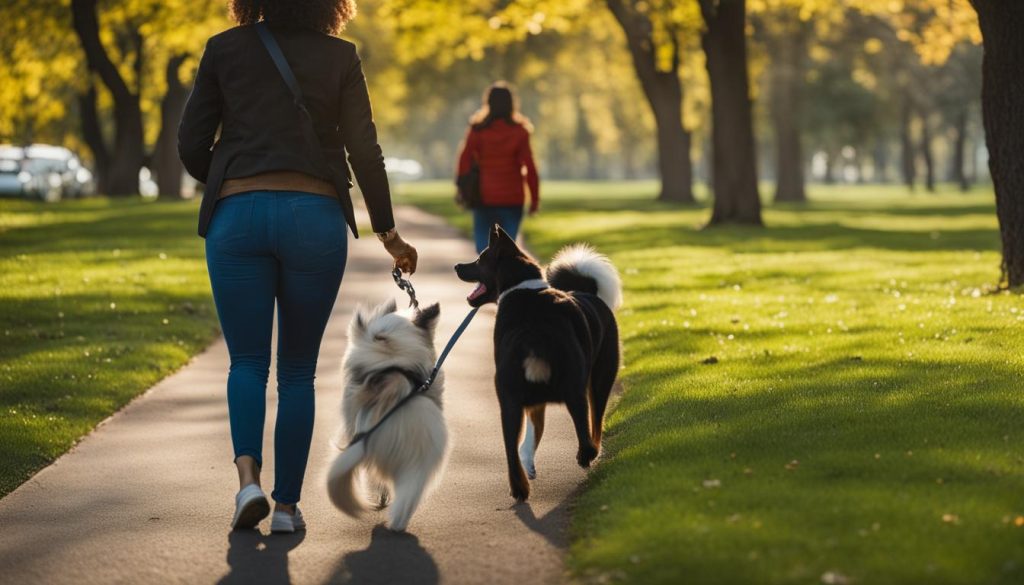
| Benefits of Positive Reinforcement in Loose Leash Walking Training | Examples of Positive Reinforcement |
|---|---|
| Builds a positive association with loose leash walking | Verbal praise |
| Strengthens the bond between you and your dog | Treats |
| Motivates your dog to continue exhibiting loose leash walking behavior | Playtime |
| Increases your dog’s trust and cooperation | Clicker training |
Using positive reinforcement in your loose leash walking training not only yields effective results but also promotes a positive and harmonious relationship with your dog. By consistently rewarding desired behavior, you can create a strong foundation for loose leash walking success.
Overcoming Challenges and Distractions
Training your dog to walk on a loose leash can be a rewarding but challenging endeavor. Along the way, you may encounter various distractions and obstacles that can hinder your progress. In this section, I will share some techniques to help you overcome these challenges and achieve success in loose leash walking.
One common challenge during loose leash walking is leash reactivity. Some dogs may become reactive or aggressive when they see other dogs, which can make walks stressful and difficult. To address this, gradually desensitize your dog to the presence of other dogs. Start by keeping a safe distance from other dogs and rewarding your dog for calm behavior. Gradually decrease the distance over time as your dog becomes more comfortable.
Another challenge is maintaining focus in high-distraction environments. Dogs are naturally curious and may be easily distracted by their surroundings. To combat this, practice loose leash walking in different environments, gradually increasing the level of distractions. Use high-value treats or toys to keep your dog engaged and reward them for maintaining focus. Consistency and patience will be key in training your dog to remain focused even in challenging situations.
| Challenge | Technique |
|---|---|
| Leash Reactivity | Gradually desensitize your dog to the presence of other dogs, rewarding calm behavior and gradually decreasing the distance. |
| High-Distraction Environments | Practice loose leash walking in different environments, gradually increasing the level of distractions. Use high-value treats or toys to keep your dog engaged and reward them for maintaining focus. |
“Training your dog to walk on a loose leash can be challenging, but with consistency and patience, you can overcome any distractions or obstacles that come your way.” – Professional Dog Trainer
Don’t forget that every dog is unique, and what works for one may not work for another. I recommend that you tailor your training techniques to suit your dog’s individual needs. Stay calm, patient, and persistent throughout the training process, and celebrate small victories along the way. With time and dedication, you and your dog will develop a strong foundation of loose leash walking skills.

Consistency and Patience
Consistency and patience are key when it comes to training your dog for loose leash walking. This skill takes time and practice to master, so remain committed and patient throughout the process. By consistently reinforcing the desired behavior and maintaining a calm and positive attitude, you can effectively teach your dog to walk politely by your side.
During loose leash walking training, consistency is crucial in terms of your techniques and expectations. I recommend that you establish clear rules and expectations from the start and remain consistent in enforcing them during every walk. This helps your dog understand what is expected of them and reinforces the desired behavior consistently.
Patience is equally important. Each dog learns at their own pace, so be patient and understanding throughout the training process. Don’t forget that mistakes and setbacks are normal and to be expected. Stay calm and positive, and continue to reinforce and reward your dog’s progress.
Tips for Consistency and Patience in Loose Leash Walking Training
- Set aside dedicated time for training sessions. Consistency requires regular practice, so establish a routine and stick to it.
- Be patient with your dog’s learning process. Some dogs may pick up loose leash walking quickly, while others may require more time and repetition.
- Focus on small victories and progress. Celebrate each successful walk and reward your dog for their efforts.
- Use positive reinforcement techniques consistently. Reward your dog with treats, praise, and play when they walk politely on a loose leash.
- Stay calm and avoid frustration. Dogs can sense your emotions, so remain calm and patient during training sessions.
By maintaining consistency and patience in your loose leash walking training, you can achieve success and enjoy stress-free walks with your dog. Try to stay committed, reinforce positive behavior, and show understanding throughout the process. With time and practice, you and your dog will build a stronger bond and experience the benefits of loose leash walking.

Choosing the Right Equipment
When it comes to loose leash walking, having the right equipment is essential. By choosing the appropriate tools, you can set yourself and your dog up for success in achieving a loose leash walking experience. Here are some key equipment options to consider:
Collar or Harness
One of the first things to consider is the type of collar or harness you will use during your walks. I recommend that you select a collar or harness that provides control without encouraging pulling. Options such as martingale collars or front-clip harnesses can be effective in redirecting your dog’s attention and discouraging pulling behaviors.
Treat Pouch and Clicker
A treat pouch is a handy tool for carrying rewards during your walks. It allows for quick and easy access to treats, which can be used to reinforce positive behaviors during loose leash walking training. Additionally, a clicker can be a useful tool for marking desired behaviors and signaling to your dog that they have done something right.
Durable Leash
Choosing a sturdy and comfortable leash is crucial for maintaining control and providing a comfortable experience for both you and your dog. Consider a biothane leash, known for its durability and waterproof properties. It is also important to choose a leash of appropriate length that allows your dog some freedom of movement while still ensuring you have control.
To put it simply, every dog is different, so it may take some trial and error to find the equipment that works best for you and your canine companion. By selecting the right collar or harness, using a treat pouch and clicker, and opting for a durable leash, you’ll be well on your way to achieving loose leash walking success.
| Equipment | Description | Recommended Brands |
|---|---|---|
| Collar or Harness | Provides control without encouraging pulling | Martingale collars, front-clip harnesses |
| Treat Pouch and Clicker | Enables easy access to treats and marks desired behaviors | Various options available |
| Durable Leash | Sturdy and comfortable for control and comfort | Biothane leashes |
Final Thoughts
Mastering the art of loose leash walking is essential for enjoying stress-free walks with your dog. By using the basic tools discussed in this guide, establishing a foundation of basic obedience, and incorporating positive reinforcement techniques, you can teach your dog to walk politely by your side.
Choosing the right equipment, such as a sturdy leash, a collar or harness that provides control without encouraging pulling, and accessories like a treat pouch and clicker, is crucial for successful loose leash walking. These tools help facilitate effective training and communication with your dog.
Try to be patient and consistent in your training efforts. Loose leash walking is a skill that takes time and practice to master. With dedication and perseverance, you and your dog will experience the benefits of loose leash walking, such as a closer bond and more enjoyable walks together.
So, equip yourself with the right tools, establish a foundation of basic obedience, and apply positive reinforcement techniques. Get ready to embark on a journey of loose leash walking success and enjoy the many rewards it brings!
FAQ
Why is loose leash walking important?
Loose leash walking improves the overall walking experience for both you and your dog by preventing pulling and allowing for better control.
What tools do I need for loose leash walking?
Essential tools for loose leash walking include a treat pouch, treats, a collar or harness, a clicker, and a biothane leash for durability and comfort.
What techniques can I use to teach my dog loose leash walking?
Effective techniques include the “Be a Tree” method and the “Turn and Walk” method, which discourage pulling and encourage focus on the handler.
Why is basic obedience important for loose leash walking?
Basic obedience provides a foundation for successful loose leash walking by establishing focus and responsiveness to commands.
Should I start loose leash walking training indoors or outdoors?
It is recommended to start loose leash walking training indoors in a low-distraction environment to establish a foundation before moving to higher-distraction outdoor settings.
What are structured walks and why are they important?
Structured walks involve walking without sniffing, marking, or greeting other dogs or distractions, creating a focused and mentally stimulating experience for your dog.
How can I use positive reinforcement to train loose leash walking?
Positive reinforcement involves rewarding your dog with praise, treats, or play when they walk politely on a loose leash, reinforcing desired behavior.
How can I overcome challenges and distractions during loose leash walking?
Techniques for overcoming challenges include addressing leash reactivity, managing distractions from other animals, and maintaining focus in high-distraction environments.
Why is consistency and patience important in loose leash walking training?
Consistency and patience help your dog understand expectations and reinforce desired behavior over time.
What equipment should I choose for loose leash walking?
Choose a sturdy leash, a collar or harness that provides control without encouraging pulling, and accessories like a treat pouch and clicker.
How can I master loose leash walking?
With the right tools, training techniques, basic obedience foundation, and consistency, you can achieve loose leash walking success and strengthen the bond with your dog.


